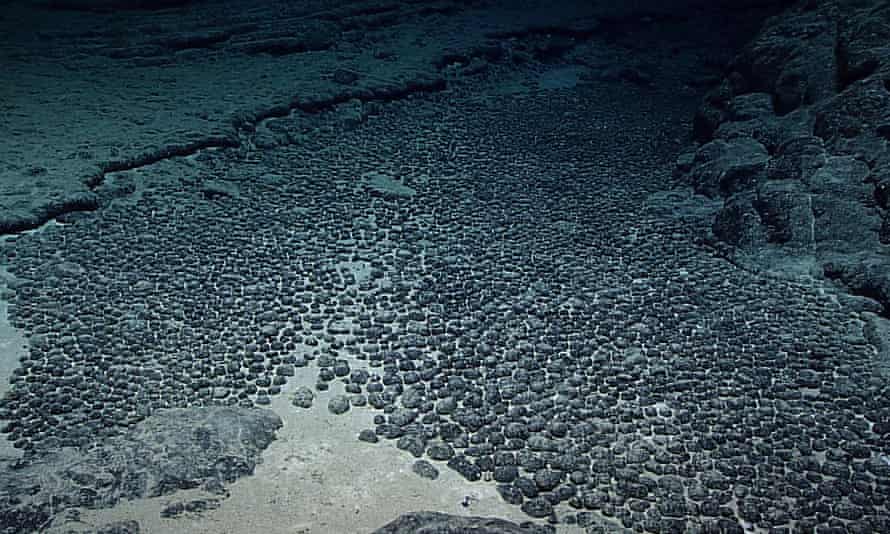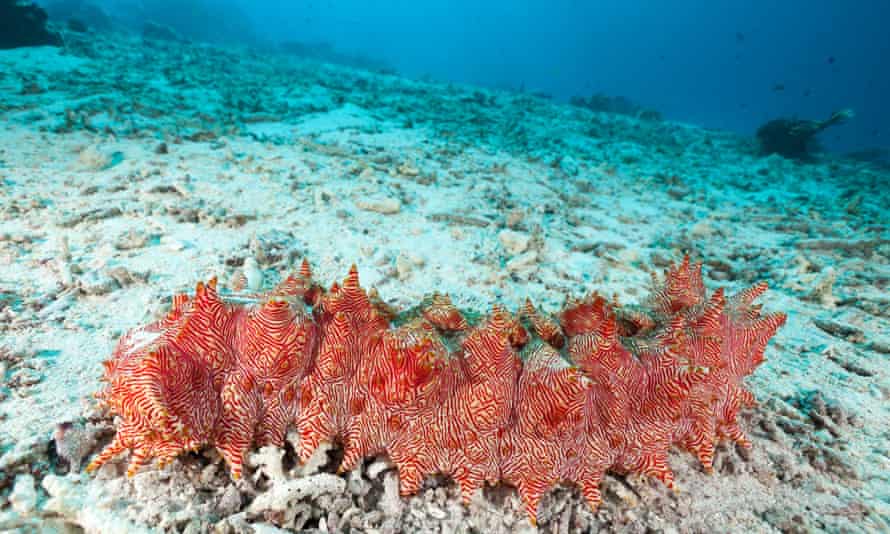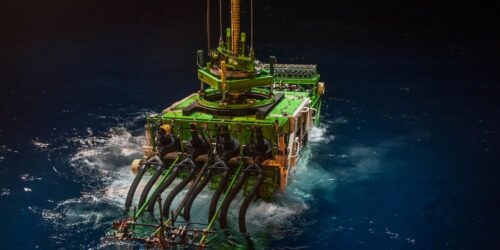In a display cabinet in the recently opened Our Broken Planet exhibition in London’s Natural History Museum, curators have placed a small nugget of dark material covered with faint indentations. The blackened lump could easily be mistaken for coal. Its true nature is much more intriguing, however.
The nugget is a polymetallic nodule and oceanographers have discovered trillions of them litter Earth’s ocean floors. Each is rich in manganese, nickel, cobalt and copper, some of the most important ingredients for making the electric cars, wind turbines and solar panels that we need to replace the carbon-emitting lorries, power plants and factories now wrecking our climate.
These metallic morsels could therefore help humanity save itself from the ravages of global warming, argue mining companies who say their extraction should be rated an international priority. By dredging up nodules from the deep we can slow the scorching of our planet’s ravaged surface.
“We desperately need substantial amounts of manganese, nickel, cobalt and copper to build electric cars and power plants,” says Hans Smit, chief executive of Florida’s Oceans Minerals, which has announced plans to mine for nodules. “We cannot increase land supplies of these metals without having a significant environmental impact. The only alternative lies in the ocean.”
Other researchers disagree – vehemently. They say mining deep-sea nodules would be catastrophic for our already stressed, plastic-ridden, overheated oceans. Delicate, long-living denizens of the deep – polychaete worms, sea cucumbers, corals and squid – would be obliterated by dredging. At the same time, plumes of sediments, laced with toxic metals, would be sent spiralling upwards to poison marine food-chains.
“It is hard to imagine how seabed mines could feasibly operate without devastating species and ecosystems,” says UK marine biologist Helen Scales – a view shared by David Attenborough, who has called for a moratorium on all deep-sea mining plans. “Mining means destruction and in this case it means the destruction of an ecosystem about which we know pathetically little,” he says.
It is a highly polarised dispute. On one side, proponents of nodule extraction claim it could save the world, while opponents warn it could unleash fresh ecological mayhem. For better or worse, these mineral spheres are going to play a critical role in determining our future – either by extricating us from our current ecological woes or by triggering even more calamitous outcomes.

Polymetallic nodules were first discovered during the 1872-6 expedition of HMS Challenger, whose round-the-world voyage laid the foundations of modern oceanography. Hauled from seabeds more than 4,000 metres deep, they were initially thought to be formed from volcanic rocks and salts. Later it was shown they grow by absorbing metal compounds in seawater.
Typically, a nodule takes shape around an object – like a clam shell – that has fallen onto the seabed,” says marine biologist Adrian Glover of the Natural History Museum, London. “The one we have just put on display formed around the tooth of a megalodon, a species of giant shark that became extinct more than 3m years ago. That shows how longa nodule takes to grow on the seabed – about a centimetre every million years.”
Despite this aeons-long accretion rate, trillions of nodules now cover the ocean bed. Some regions are so densely packed with them they look like cobbled streets. The Clarion-Clipperton Zone (CCZ) – which stretches from Mexico to Hawaii and covers more than 4 million square kilometres of seabed – is particularly rich in nodules, with estimates suggesting there is six times more cobalt and three times more nickel there than in the world’s entire land-based reserves.
These riches have sparked the interest of mining and dredging companies, which are now lining up to get approval to explore the Clarion-Clipperton. To date, more than 20 exploration contracts have been awarded by the International Seabed Authority (ISA), the UN body responsible for controlling mining on international waters.
Ultimately these companies hope to transform their exploration contracts into permits to extract the abyss’s mineral treasures and bring them to the surface. It will not be an easy task. On the dark ocean floor, pressure is 500 times greater than at the surface – the equivalent of lying underneath a stack of several dozen jumbo jets.
To get around these hurdles, huge surface ships will be needed – to lower pipelines attached to robot bulldozers, which would then trundle over the deep sea floor sucking up nodules, before pumping them back to the surface five kilometres overhead.Advertisement
It sounds ambitious. Yet mining companies are upbeat. “We have built robot craft that run over the seabed to search for diamonds off the coast of Namibia and to build deep-sea pipeline trenches,” said Laurens de Jonge, manager of marine mining at Royal IHC, the Dutch supplier of maritime technology for dredging, offshore energy and mining.
The abyss means working at greater depths and pressures which will certainly involve new challenges, including our main focus: to limit the environmental impact as much as possible. However, we do not expect major differences occurring between past operations and future nodule mining. I would anticipate that once a company has decided to commit to a seabed mining operation and has been given an extraction licence, it could probably get under way in around three years.”
As part of its plans, Royal IHC has designed a 16-metre-wide robot and built a three-metre test vehicle – called Apollo II – which would be able to gather about 400 tonnes of nodules in an hour and pump them aloft. Over two weeks’ operation, more than 100,000 tonnes could be removed this way. And after operating for 25 to 30 years – the anticipated limit for an ISA extraction licence – about 10,000 square kilometres of the seabed could be strip-mined.
Extraction on this scale makes many marine biologists blanch – for its likely effect on deep-sea life could be profound and widespread, a point stressed by marine biologist Callum Roberts, of York University. “Nodules provide the only hard substrates in the thousands of square kilometres of the fine sedimentary ooze that covers the abyssal plain,” he says. “They are critical attachment points for a variety of creatures that cannot live directly in mud.”
These residents include anemones, sponges, corals, nematode worms, and microscopic creatures called tardigrades – as well as octopuses, which have recently been found to lay eggs in sponges attached to nodules. “The biomass of the animals in the sediment is very low,” says ocean biologist Cindy van Dover, of Duke University. “However, the diversity is very high.”
In fact, vast numbers of species still remain to be discovered in the abyss, say scientists, and many would be obliterated by deep-sea mining before they have been identified. “As the mining machines thunder across the seabed, they would kick up fine, muddy clouds that would hang in the water, because no strong currents are there to disperse them,” says Scales in her recent book, The Brilliant Abyss. “Delicate animals caught in these clouds and unable to swim away, like corals and sponges, would be smothered and choked.”

Advertisement
Nor would there be any chance of a quick recovery from the onslaught. At these depths, where food and energy are limited, life proceeds at an extraordinarily slow rate. Populations could take centuries to recover.
These dangers were summed up in a recent report by the international conservation charity Fauna and Flora International. “Deep seabed mining will result in large-scale habitat removal,” it states. “It will also produce sediment plumes which will disrupt ecological function and behavioural ecology of deep-ocean species, smothering fundamental ecological processes over vast areas.”
For their part, mining companies stress they do not plan to start nodule dredging until full environmental assessments of their proposals are completed. These are now being worked on by ecologists, marine biologists and oceanographers.
In addition, companies such as Ocean Minerals point to the damage done by mines on land, which create sinkholes, trigger biodiversity loss, and cause widespread contamination of soil and surface water. “In our considered opinion, the impact of nodule mining will be magnitudes less than the equivalent impact of the mining on land for the volumes of metals we will need in future,” says Smit.
Pressure to obtain these metals in sufficient volumes is certainly going to become intense, analysts agree. One estimate, by the World Bank, suggests there will have to be a 500% growth in cobalt production by 2050 if demands for electric vehicle batteries and turbine manufacture are to be met. Nevertheless, deep-mining opponents say such forecasts still do not justify ploughing up the abyssal plain and point to two other approaches – metal recycling and alternative green technologies – that could reduce the need to mine for cobalt, manganese, nickel and copper.
In the first case, these elements could be extracted from old electric-car batteries and used to make new ones. This recycling would limit the need to mine for fresh supplies of metal ores. And the concept is a useful one, acknowledges Professor Richard Herrington, head of earth sciences at the Natural History Museum, London. “Recycling is going to be important but it will not be enough on its own. By 2035, we might have about 35 to 40% of these metals from recycling – if we can get our act together now.
“Where we get the other 60 to 65% is a different issue and a museum like ours has a real role to pay here – to get people to think about where we should extract the metals we need to save the world. These issues are going to shape our lives in the next few decades, after all.”






